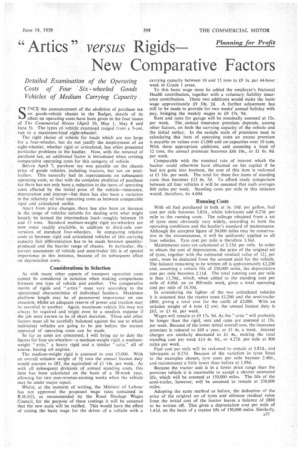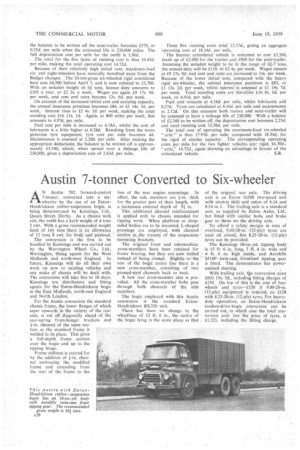" Artics " versus Rigids— Plan!" g for Profit New Comparative Factors
Page 39

Page 40

If you've noticed an error in this article please click here to report it so we can fix it.
Detailed Examination of the Operating Costs of Four Sixwheeled Goods Vehicles of Medium Carrying Capacity _
cl INCE the announcement of the abolition of purchase tax on goods-vehicle chassis in the Budget, details of its . effect on operating costs have been given in the four issues
•
of The Commercial Motor (April 10, May I, May 8 and June 5). The types of• vehicle examined ranged from a 5-cwt. van to a maximum-load eight-wheelei.
The right choice of vehicle for loads which are too large for a four-wheeler, but do not justify the employment of an eight-wheeler, whether rigid or articulated, has often presented particular problems to the haulier. Now, with the removal of purchase tax, an additional factor is introduced when revising comparative operating costs for this category of vehicle, Before April 7, purchase tax was payable on the chassis price of goods vehicles, including tractors, but not on semitrailers. This naturally had its repercussions on subsequent operating costs, so that with the complete abolition of purchase tax there has not only been a reduction in the items of operating costs affected by the initial price of the vehicle—insurance, depreciation and interest—but there has also been a variation in the relativity of total operating costs as between comparable . rigid and articulated outfits.
Apart from price changes, there has also been an increase in the range of vehicles suitable for dealing with what might loosely be termed the intermediate load—roughly between 10 • and 15 tons. Standard medium-weight rigid six-wheelers are now more readily available, in addition to third-axle conversions of standard four-wheelers. In comparing relative costs as between rigid and articulated vehicles of this carrying capacity fair differentiation has to be made between quantityproduced and the heavier range of chassis. In particular, the correct assessment of vehicle and semi-trailer life is of special • importance in this instance, because of its subsequent effect on depreciation costs.
Considerations in Selection
• As with many other aspects of transport operatiori costs cannot be considered in isolation when making comparisons between one type of vehicle and another. The comparative merits of rigids and " artics" must vary according to the operational characteristics of individual hauliers. Maximum platform length may be of paramount importance on one occasion, whilst an adequate reserve of power and traction may . be essential in another. Again, maximum vehicle life may not always be required and might even be a needless expense if the job were known to be of short duration. These and other factors must all be carefully balanced against the use to which individual vehicles are going to be put before the correct appraisal of operating costs can be made.
So far as costs are concerned, I will bring up to date the figures for four six-wheelers—a medium-weight rigid, a mediumweight " artic," a heavy rigid and a similar " artic," all of course, having oil engines.
The medium-weight rigid is assumed to cost £3,000. With an overall unladen weight of 51 tons the annual licence duty would amount to 185, the equivalent of £1 14s. per week. As with all subsequent divisions of • annual standing costs, this item has been calculated On the basis of a 50-week year, allowing for two non-revenue-earning weeks when the vehicle may be under major repair.
Whilst, at the moment of writing, the Minister of Labour has not approved the proposed wage rates contained in R.H.(65), as recommended by the Road Haulage Wage's Council, for the purpose of these costings it will be assumed that the new scale will be ratified. This would have the effect of raising the basic wage for the driver of a vehicle with a carrying capacity between 10 and 15 tons to £9 Is. per 44-hour week in Grade 1 areas.
To this basic wage must be added the employer's National Health contribution, together with a voluntary liability insurance contribution. These two additions would make the basic wage approximately £9 10s. 2d. A further adjustment has still to be made to provide for two weeks' annual holiday with pay, bringing the weekly wages to £9 17s. 9d.
Rent and rates for garage will be nominally assessed at 12s. per week. The,. annual insurance premium depends, among other Factors, on both the carrying capacity of the vehicle and the initial outlay. In the sample scale of premiums used in calculating this item of operating costs an excess premium is payable on values over £1,000 arid on capacities over 10 tons. With these appropriate additions, and assuming a load of 12 tons, the annual premium becomes £66 10s., or fl 6s. 13d. per week.
Comparable with the nominal rate of interest which the haulier could otherwise have obtained on his capital if he had not gone into business, the cost of this item is reckoned at £1 16s. per week. The total for these five items of standing costs thus becomes £15 6s. 5d. To afford ready comparison between all four vehicles it will be assumed that each averages 800 miles per week. Standing costs per mile in this instance would, therefore, be 4.60d.
Running Costs
With oil fuel purchased in bulk at 3s. 10d. per gallon, fuel cost per mile becomes 3.83d., whilst lubricants add 0.27d. per mile to the running costs. The mileage obtained from a set of tyres must obviously vary widely, according to both the operating conditions and the haulier's standard of maintenance. Although the accepted figure of 30,000 miles may be conservative in the circumstances, it will be uniformly applied to all four vehicles. Tyre cost per mile is therefore 3.36d.
Maintenance costs are calculated at 2.13d. per mile. In order to obtain the cost of depreciation, the price of the original set of tyres, together with the estimated residual value of 12A per cent., must be deducted from the amount paid for the vehicle. The balance remaining to be written off is approximately £2,200 and, assuming a vehicle life of 250,000 miles, the depreciation cost per mile becomes 2.11d. The total running cost per mile is thus 11,70d., which, when added to the standing cost per mile of 4.60d. on an 800-mile week, gives a total operating cost per mile of 16.30c1.
In considering the lighter of the two articulated vehicles it is assumed that the tractor•costs £1,200 and the semi-trailer £800, giving a total cost for the outfit of £2,000. With an unladen weight of 4 tons 12 cwt. the annual licence duty is £65, or £1 6s. per week.
Wages will remain at £9 17s. 9d. As the " artic " will probably be longer than the rigid, rent and rates are assessed at 13s. per week. Because of the lower initial overall cost, the insurance premium is reduced to £60 a year, or £1 4s. a week. Interest charges are similarly decreased to £1 4s., making the total standing cost per week £14 4s. 9d., or 4.27d. per mile at 800 miles per week.
Fuel cost per mile will be reckoned to remain at 3.83d., and lubricants at 0.27d. Because of the variation in tyres fitted to the examples chosen, tyre costs per mile become 2.40d., and maintenance a little lower than before at 1.99d.
Because the tractor unit is in a lower price range than the previous vehicle it is reasonable to accept a shorter estimated life, which will be assessed at 150,000 miles. The life of the semi-trader, however, will be assumed to remain at 250,000 miles.
Adopting the same method as before, the deduction of the price of the original set of tyres and ultimate residual value from the initial cost of the tractor leaves a balance of £880 to be written off. This gives a depreciation cost per mile of 1.41d. on the basis of a tractor life of 150,000 miles. Similarly, the balance to be written off the semi-trailer becomes 1570, or 0.55i1 per mile when the estimated life is 250.000 miles. The full depreciation cost per mile for the outfit is 1.96d.
The total for the five items of running cost is thus 10.45d. per mile, making the total operating cost 14.72d.
Because of their relatively high initial cost, maximum-load sixand eight-wheelers have naturally benefited most from the Budget changes. The 20-ton-gross six-wheeled rigid considered here cost £4,500 before April 7, and is now reduced to £3,700. With an unladen 'weight of 6/ tons, licence duty amounts to £105 a year, or £2 2s. a week. Wages are again £9 17s. 9d. per week, and rent and rates become 12s. fid per week.
On account of the increased initial cost and carrying capacity, the annual insurance premium becomes £86, or Li 14s. 5d. per week. Interest rises to £2 4s. 5d. per week, making the total standing cost €16 us. Id. Again, at 800 miles per week, this amounts to 4.97d. per mile.
Fuel cost per mile is increased to 4.18d,, whilst the cost of lubricants is a little higher at 0.28d. Resulting from the more generous tyre equipment, tyre cost per mile becomes 4d. Maintenance is assessed at 2.28d. per mile. After making the appropriate deductions, the balance to be written off is approximately 13,740, which, when spread over a Mileage life of 250,000, gives a depreciation cost of 2.63d. per mile. These, five running costs total 13.37d., giving an aggregate operating cost of 18.34d per mile.
The heavier articulated vehicle is reckoned to cost £3,300, made up of 12,400 for the tractor and 1900 for the semi-trailer. Assuming the unladen weight to be in the range of 61-7 tons, the annual duty will be £110, or 12 4s. per week. Wages remain at £9 17s. 9d. and rent and rates are increased to 14s. per week. Because of the tower initial cost, compared with the heavy rigid six-wheeler, the annual insurance premium is £83, or £1 13s. 2d. per week, whilst interest' is assessed at £1 19s. 7d. per week. Total standing costs are therefore £16 8s. 6d. per week, or 4.93d, per mile.
Fuel cost remains at 4:18d: per mile, whilst lubricants add 0.27d. Tyres are calculated at 4.16d. per mile and maintenance at 2.I2d. On this occasion both tractor and semi-trailer will be assumed to have a mileage life of 250,000. With a balance of £2,340 to he written off, the depreciation cost becomes 2.25d, and total running cost 12,98d. per mile.
The total cost of operating the maximum-load six-wheeled " artic " is thus 17.9rd. per mile, compared with 18.34d. for the rigid of similar capacity. The corresponding operating costs per mile for the two lighter vehicles are rigid, 16.30d.; " artic," 14.72d., again showing an advantage in favour of the articulated vehicle. S.B.




































































